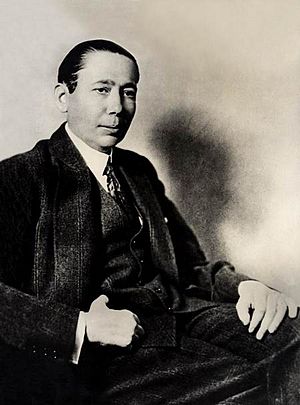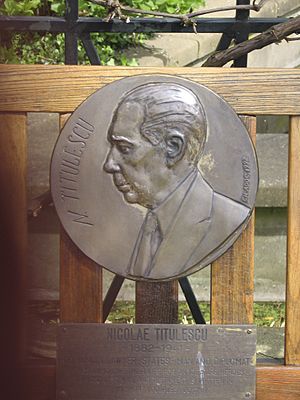Nicolae Titulescu facts for kids
Quick facts for kids
Nicolae Titulescu
|
|
|---|---|
 |
|
| Minister of Foreign Affairs of Romania | |
| In office 10 October 1934 – 28 August 1936 |
|
| Monarch | Carol II |
| Preceded by | Gheorghe Tătărescu |
| Succeeded by | Victor Antonescu |
| In office 20 October 1932 – 1 October 1934 |
|
| Monarch | Carol II |
| Preceded by | Alexandru Vaida-Voevod |
| Succeeded by | Gheorghe Tătărescu |
| In office 24 November 1927 – 9 November 1928 |
|
| Monarch | Michael I |
| Preceded by | Ion I. C. Brătianu |
| Succeeded by | Gheorghe Mironescu |
| President of the Assembly of the League of Nations | |
| In office 1930–1932 |
|
| Preceded by | José Gustavo Guerrero |
| Succeeded by | Paul Hymans |
| Personal details | |
| Born | 4 March 1882 Craiova, Romania |
| Died | 17 March 1941 (aged 59) Cannes, Vichy France |
| Spouse | Catherine Titulescu |
Nicolae Titulescu (Romanian pronunciation: [nikoˈla.e tituˈlesku]; 4 March 1882 – 17 March 1941) was an important Romanian politician and diplomat. He served as an ambassador, a finance minister, and a foreign minister for Romania. He was also chosen twice to be the president of the General Assembly of the League of Nations, an international organization that worked for world peace.
Contents
Early Life and Education
Nicolae Titulescu was born in Craiova, Romania, on March 4, 1882. His father was a lawyer. Nicolae grew up on his father's estate in a village called Titulești. This village was later named after him.
In 1900, Titulescu finished high school at the Carol I National College in Craiova with excellent grades. He then went to Paris to study law. He earned his doctorate degree, which is a very high academic qualification, in 1905.
After finishing his studies, Titulescu returned to Romania. He became a law professor at the University of Iași. In 1907, he moved to Bucharest, the capital city of Romania.
Political Career Highlights
In 1912, Nicolae Titulescu became a member of the Romanian parliament. He was part of the Conservative-Democratic Party. Five years later, he joined the government as the Minister of Finance. This meant he was in charge of the country's money matters.
In 1918, during World War I, Titulescu went to Paris. There, he joined other important Romanians to form the National Romanian Committee. Their goal was to show the world that the Romanian people wanted to be united as one nation. This committee was officially recognized as representing the Romanian nation.
After the war, Titulescu served again as finance minister from 1920 to 1921. He was then appointed as the Romanian Ambassador to the United Kingdom. He held this important job on and off until 1936.
Working for Peace at the League of Nations
Starting in 1921, Titulescu became Romania's permanent representative to the League of Nations in Geneva. This organization was created after World War I to help keep peace around the world.
Titulescu was chosen twice, in 1930 and 1931, to be the president of the League of Nations. In this role, he worked very hard for peace. He believed in keeping borders stable and having good relationships between all countries, big or small.
He also strongly supported the idea that all nations should be treated equally and respect each other's independence. Titulescu pushed for "collective security," which means countries working together to prevent wars and stop any country that tries to attack another.
In June 1936, a famous event happened at the League of Nations. When Emperor Haile Selassie I of Ethiopia spoke to the League after his country was invaded by Italy, some Italian journalists were disrespectful. Titulescu stood up and shouted, "To the door with the savages!" This showed how strongly he felt about justice and respect between nations.
Foreign Minister and Diplomatic Efforts
Titulescu served as Romania's Minister of Foreign Affairs from 1927 to 1928, and again from 1932 to 1936. In this role, he worked to build strong relationships with other countries.
He believed that Romania needed an alliance with the Soviet Union. He had many discussions with the Soviet foreign minister, Maxim Litvinov. However, these plans did not succeed because King Carol II and other Romanian leaders did not support them.
In 1935, Nicolae Titulescu was recognized for his achievements and became a full member of the Romanian Academy.
Exile and Final Resting Place
In August 1936, King Carol II removed Titulescu from all his government jobs and asked him to leave Romania. Titulescu first moved to Switzerland and then to France.
Even in exile, he continued to speak and write about the importance of peace. He saw the danger of another big war approaching. He briefly returned to Romania in November 1937, but soon left again for France.
In France, he spoke out against the fascist government that was taking power in Romania. Nicolae Titulescu passed away in Cannes, France, on March 17, 1941, after a long illness. In his will, he wished to be buried in Romania.
After the fall of communism in Romania in 1989, his wish could finally be granted. On March 14, 1992, his remains were brought back to Romania. He was reburied in the Sfânta Ecaterina cemetery in Șcheii Brașovului, near St. Nicholas Church in Brașov. He received many honors during his life, including the Order of the White Eagle.
See also
 In Spanish: Nicolae Titulescu para niños
In Spanish: Nicolae Titulescu para niños


